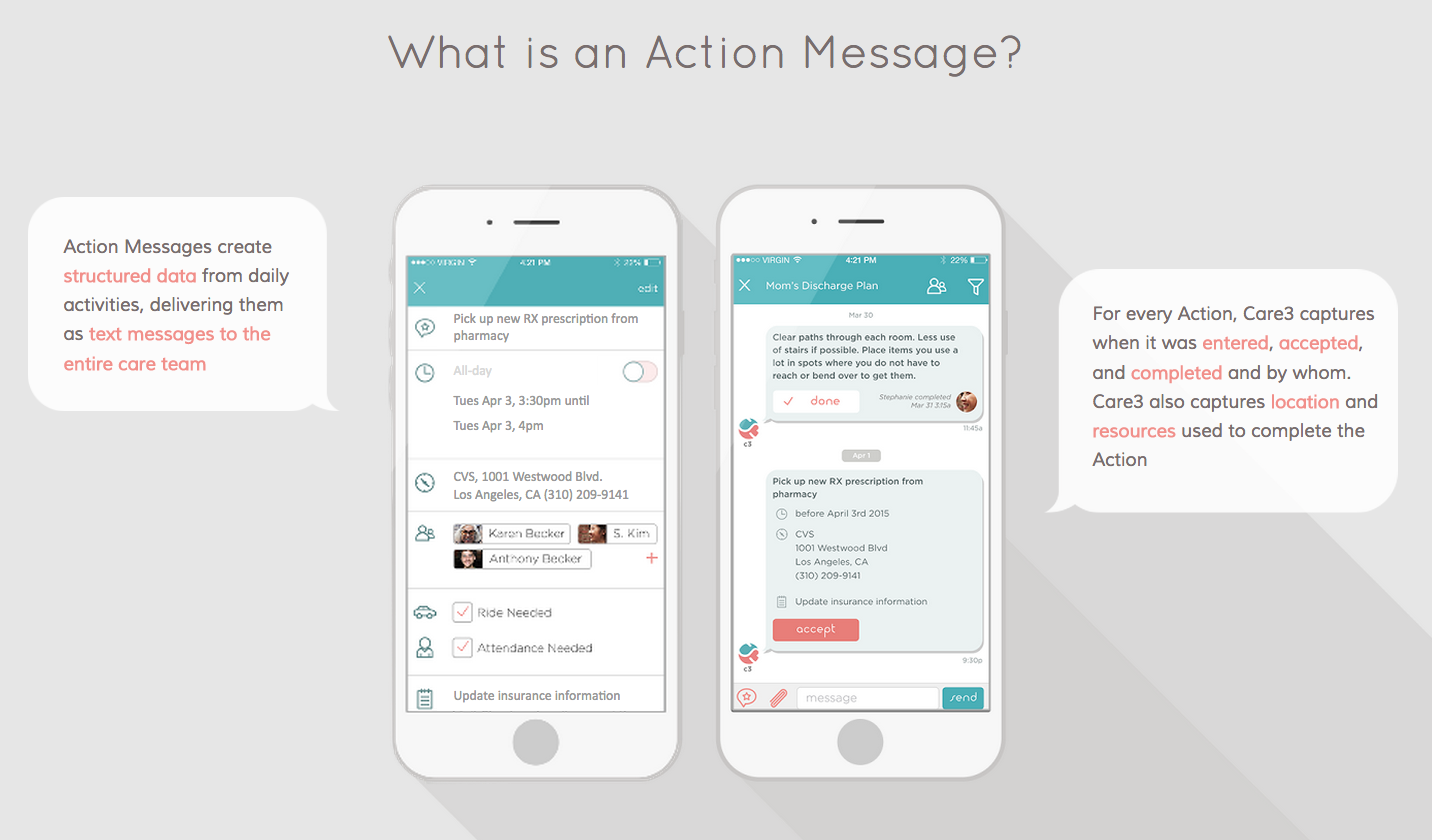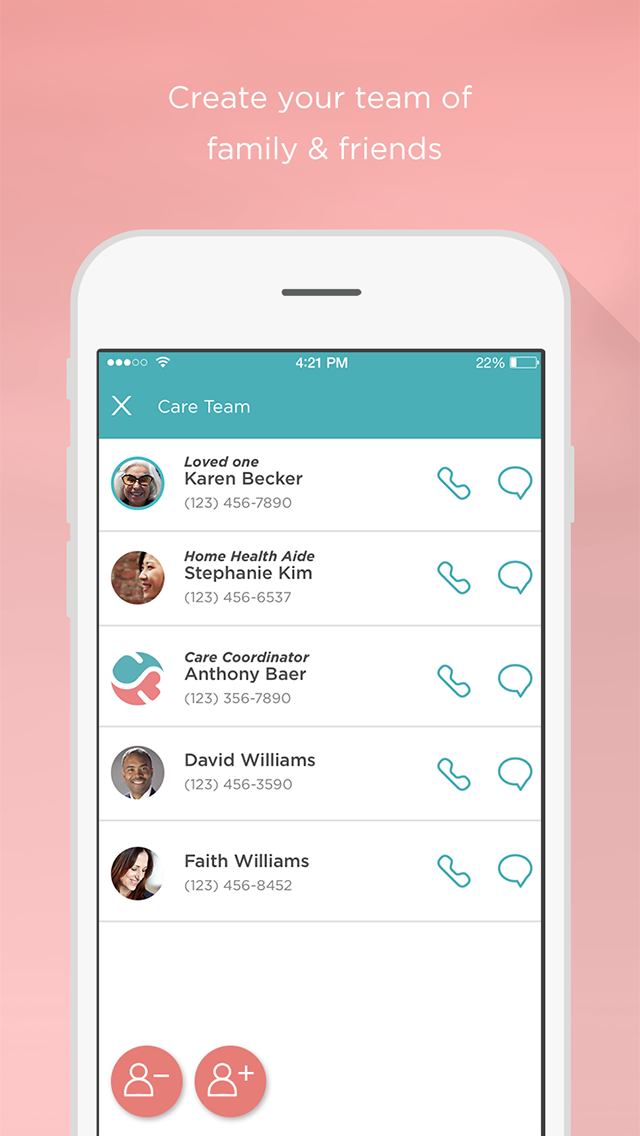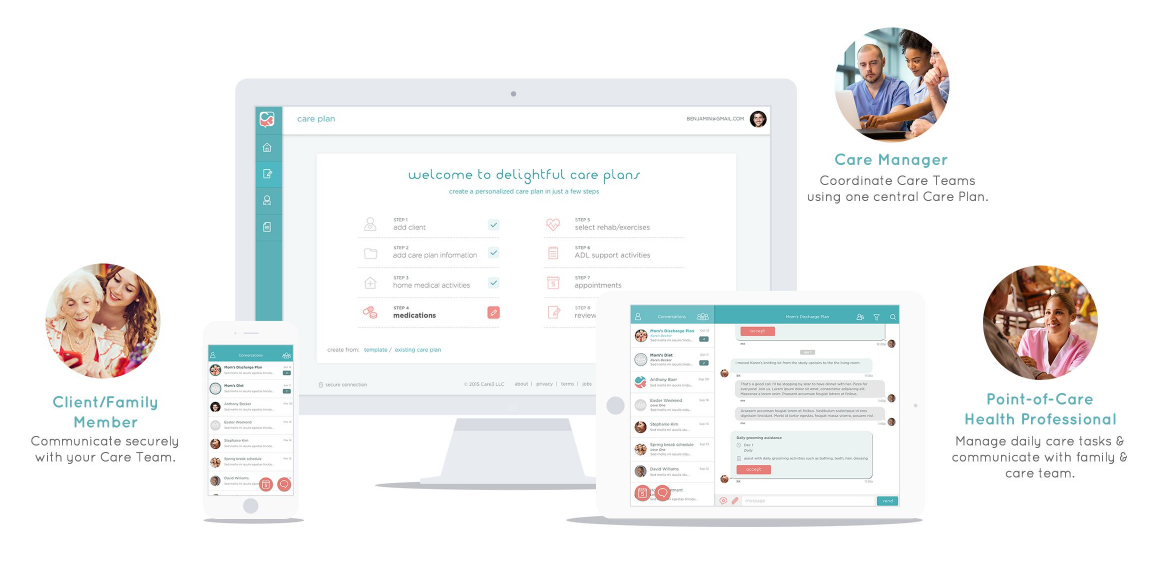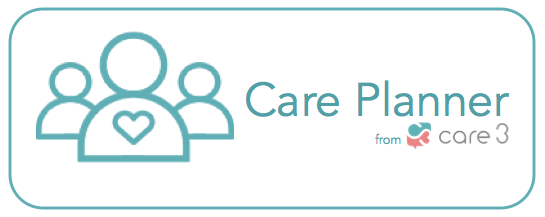Care3 News & Events
Care3 CEO David Williams Honored as Entrepreneur of the Week by The Longevity Network
The Longevity Network (www.longevitynetwork.org) has recognized Care3 co-Founder and CEO, David Williams as Entrepreneur of the Week. The Longevity Network was created to give Investors and Entrepreneurs the resources needed to create breakthrough products, experiences, and business models for health technologies benefitting the 50+ audience. The Longevity Network published an interview with David where he shared his thoughts on healthcare, entrepreneurship, digital health, care coordination, and other topics.
Here's an excerpt from the interview:
LN: How has what happened with Care3 differed from what you imagined would happen with Care3?
DW: Caregivers started using our Action Messages (patent-pending) sooner than we thought. An Action Message is a care task delivered as a text message (or media message) that has accountability attached to it. A caregiver can accept the task, which notifies the Care Team that the task will be done. Once completed, the caregiver can tap the “done” button notifying everyone of completion.
We thought it would take longer for caregivers to adopt this hybrid messaging/tasks behavior but we’re happy to say that we’ve seen a steady increase in Action Message utilization. What this means is that caregivers are sharing more and more care tasks with each other. Action Messages are what makes “care-sharing” possible.
Congratulations, David! Check out the full interview on The Longevity Network website.
The Top 5 Non-negotiable Features for Strong Caregiving Apps
After reviewing the major caregiving apps for consumers on the market, it became very clear that none meet the criteria needed to manage care outside of the hospital. Here are the five (5) non-negotiable features needed for caregiving apps (and check out this 100 second video for a clear review of these criteria).
Mobile
Caregiving moves at the speed of life. Anytime, anywhere, something can happen, and something has to be done. So any technology for caregivers must be mobile. You're almost not in the game anymore if you don't have some kind of mobile presence or a mobile app – something that allows things to happen anytime, anywhere.
Secure
HIPAA compliance is no longer an option when it comes to sharing health information between patients and professionals using mobile devices. Therefore all mobile apps for healthcare must be secure, private, and guarantee the confidentiality of patient/family to provider communication.
Simple
The technology cannot be complicated. No one in a care situation can spend a ton of time trying to learn a new app, or some kind of new technology, when caring for a loved one and/or manage care. Finding the time to learn something tricky just isn't going to happen. It has to be simple, and it has to be intuitive, with no new behaviors.
Shareable
People want to be kept up-to-date on how patients are doing. Whether those people are helping to deliver care or not, they want to know at least what's going on, and that's why "shareability" matters. That way, you can alert family and friends of all the things that are happening quickly and effectively. Increased efficiency with updates is what the technology should provide to be ultimately shareable.
Accountable
The last one – and most important – is accountability. Caregiving is about getting it done, getting it done right, and getting it done on time, as prescribed. Not doing it – meaning failing to adhere to the care tasks and care plan – can have serious consequences. Sometimes life and death consequences. The technology must communicate, notify, and record when a task is performed. That way, we and the other people on the care team can know if there are any barriers or challenges to getting things done per the doctor's instructions. We have to follow the plan to the letter, because not doing so can have devastating effects.
Does your healthcare application meet these criteria? If not, then it's time for you to download and install the Care3 mobile messaging app. It's 100% FREE.
Care3 for Care Managers
Calling All Care Managers!
Did you know there are 65 million family caregivers in the US? These people lovingly support your clients in their quest to remain healthy. In fact, 69% of family caregivers are open to using mobile applications to help them take care of loved ones.
What if a technology platform could improve communication with your clients and their families, keep everyone informed about your work, and teach family caregivers how they can help your clients get and stay healthy?
Welcome to Care3.
Care3 is the care planning and mobile messaging platform for people who care for and about others. You care for your clients by ensuring they receive the best care possible. Your clients’ families care about their loved ones, but often don’t know how to help. Care3 brings it all together.
Care3 = Care Plan + Messaging + Calendar
If you need a system that coordinates care, makes communications with all parties efficient and compliant, and drives positive outcomes, then you need Care3. Care3 combines a simple, 8-step care planning tool with our mobile messaging and calendar app to make sure all care steps are organized and those completing the steps can care anywhere.
You create the care plan, including medications, ADLs, rehab/exercises, home medical needs and more. All individual care steps are sent to the Care3 mobile app as Actions to be completed by members of the care team--professionals and family. Everyone operates from the same central care plan that you design. It's that easy.
- Build a Care Team of interdisciplinary care providers and family members around each of your clients to keep everyone in the loop and engaged.
- Create Care Plans that family and professionals can complete so they know how to help to keep loved ones out of the hospital.
- HIPAA-compliant Text Messaging allows you to securely communicate with your clients and families and track when care steps are complete.
- Calendar and To-Do List keep everyone organized so they know what care has to be delivered when.
Care3 makes you more effective managing care which leads to higher client satisfaction and more referrals.
Dozens of Care Management Companies Use Care3
Care3 enables community-based care managers (geriatric and others) to coordinate care for clients and families. While navigating the health system, you can also ensure that the critical care that's needed to keep your clients healthy and out of the hospital is being delivered by the professional care team and family.
Here are what a few of our users are saying about Care3 for care management:
"Care3 is great for coordinating care!"
"...very intuitive out-of-the-box."
"If you are trying to keep track of service providers for a client, Care3 is your system!"
Try FREE for 60 Days
Sign up for Care3 Care Planner FREE for 60 days. Create as many care plans as you need for all of your clients. Get their families involved with care. Keep your clients out of the hospital.
Turn Your Care Plans Into Action
Doctors are required to provide care managers, patients, and family caregivers with information (e.g., care instructions) to help them reach their optimal level of health following an appointment or inpatient stay at a hospital. However, these instructions are often discussed when patients and family are not receptive to listening or able to comprehend detailed information on how to provide care outside of the hospital (e.g., at hospital discharge). On top of that, the instructions are paper-based, full of medical jargon, and often not delivered to family or case managers responsible for care outside of the doctor's office or hospital. Care3 helps solve that problem by turning paper care instructions into action so you can be ready to deliver the right care at the right time. And the Care3 mobile messaging app is HIPAA-compliant.
Care3 helps you sequence Actions over time from the care instructions recommended by a provider. The care instructions may include individual Actions including activities of daily living (ADLs), taking medicine, scheduling appointments, rides, errands, refilling prescriptions, exercise and more.
 Action messages structure the information from care instructions into individual tasks and daily activities, delivering them as text messages to the entire Care Team. For every Action, Care3 asks the care team members to accept, and complete it. Everyone knows how to help and has visibility on what tasks are complete.
Action messages structure the information from care instructions into individual tasks and daily activities, delivering them as text messages to the entire Care Team. For every Action, Care3 asks the care team members to accept, and complete it. Everyone knows how to help and has visibility on what tasks are complete.
Care3 helps you turn care instructions into action. Download the FREE Care3 app for iPhone or iPad now!
HIPAA Compliance is No Longer Optional for Mobile Messaging
In today's consumer-driven healthcare environment, it's imperative for providers, patients, and families be able to communicate in a HIPAA-compliant manner. Having a patient portal isn't enough. The engagement levels are too low. You need a HIPAA-compliant mobile messaging solution for your communications between staff and with clients and their families. Care3 is the first and only HIPAA-compliant text messaging app available directly to consumers (DTC) with integrated calendar and to-do list features. This means that you can download Care3 directly from the iTunes App Store (iPhone and iPad available) to communicate all health-related information with healthcare professionals, family members and friends with confidence. Your messages will be private, secure, and compliant with the gold standard of communication encryption and data storage.
And before you ask, the answer is yes: Care3 is 100% FREE to download.
What makes Care3 different from other HIPAA-compliant messaging apps?
Simply stated, Care3 is far more than messaging and has a bias toward action.
Care3 includes:
- HIPAA-compliant messaging to securely communicate with your staff and families.
- Care Team group conversations to include professionals and family members engaged.
- Action Messages (patent-pending) to show staff and family members what care tasks need completion and keep track of progress.
- A full-featured Calendar to review what Actions you have accepted with each day's to-do list included.
- Invitations that are sent via text message or email just by starting a new conversation.
- A Starter Care Plan template of common care tasks (fully customizable) for all Care Teams.
Care3 makes you more effective at managing care to get the best outcomes for your patients and families while not compromising privacy, security, and confidentiality while communicating. No other HIPAA-compliant messaging application provides this much functionality--whether a paid app or free. And did we mention Care3 is FREE?
Download and install the FREE Care3 mobile messaging app now! Communicate in compliance with your staff and family clients.
Leading Toward Justice in Healthcare
by David S. Williams III, co-Founder and CEO of Care3 and 2013 Henry Crown Fellow of The Aspen Institute

I had the absolute pleasure of attending The Aspen Institute's annual Action Forum last week in Aspen, CO. As the 1st inaugural Resnick Aspen Action Forum (thank you Resnick Family of The Wonderful Company!), the theme was bold: Leading Toward Justice.
The past 18 months have seen multiple shocking results within the criminal justice system with the deaths of unarmed black men at the hands of police and the subsequent lack of prosecution for these deaths. While the blame for these deaths face fierce debate in the community and the courtroom, justice can only be served when all people receive equal treatment under the law.
In what I and many attendees describe as the most powerful speech about injustice ever given, Bryan Stevenson, Executive Director of The Equal Justice Initiative brought an assembly of 400 global leaders to tears when describing the injustice he faces daily in his work with death row inmates. This speech is a MUST-SEE for anyone looking for ways to make meaningful change as he provides a four-point framework to lead toward justice.
- Get Proximate
- Change The Narratives that Maintain Injustice
- Stay Hopeful
- Be Uncomfortable
The Aspen Institute also posted a summary of Bryan's talk which, of course, doesn't do him "justice" on its own. Please watch the speech, listen, and feel what all of us in the room felt.
But injustice doesn't only apply to law enforcement and the criminal justice system in America. Think about our educational system and, most relevant to my professional work, the healthcare system.
Healthcare in America - Is Justice Served?
By any measure, the healthcare capabilities of US-based hospitals and health centers are the best in the world. With leading institutions such as Mayo Clinic, Cleveland Clinic, and many other healthcare systems, the knowledge of evidence-based care generated at these institutions gives US residents the opportunity to receive top-notch care.
Or does it?
Introducing the 2014 AHRQ National Healthcare Quality and Disparities Report. This annual scorecard measures different ways healthcare doesn't reach the "underserved" defined as the poor, people of color, the disabled, rural, and seniors. Across all measures of access, quality, and outcomes, underserved populations trail that of the general population. Is that justice?
For example, in one graphic AHRQ ranks each US state in quartiles by the quality of healthcare delivered:
On a second graphic, AHRQ charts each US state by the level of disparity in healthcare delivered based solely on race:
(Note: A similar analysis was NOT completed in the 2015 AHRQ report)
An analysis of these charts (which AHRQ curiously didn't do themselves), one can see the states in which the highest level of care is delivered, while also having the highest level of disparity of care based on race. Six (6) states fall into that dubious group: Iowa, Wisconsin, Minnesota, Massachusetts, Rhode Island and Delaware (Michigan, Pennsylvania, NY and NJ are in the second highest quartile of quality, but also have the highest level of disparity).
Again, these six states have the capability to deliver the highest quality of care for their residents--but also sport the highest disparity levels of healthcare access, quality, and outcomes based solely on the race of patients.
Is this justice?
Further complicating this picture is a recent study by researchers at Johns Hopkins Medicine published in The BMJ (formerly British Medical Journal) stating that if medical errors were counted correctly, they would rank third on the list of causes of death in the US behind cardiovascular disease and cancer. The researchers penned an open letter to the CDC asking them to update their data collection methods to account for avoidable medical errors as a cause of death, not simply the underlying disease that led to the need for acute care. Their methodology in coming to that conclusion could also be applied to the environments in which healthcare disparities exist by race.
It doesn't take a scientist to recognize that a disproportionate level of medical errors likely occur to those in underserved populations. There is no accountability for avoidable medical errors in the same manner that (theoretically) the criminal justice system could apply accountability for broken laws because those medical errors are not counted.
If a disproportionate amount of the 250,000 suspected avoidable medical errors that lead to death in the US happen to patients in underserved populations because of poor quality being delivered, isn't that the same as unconscious bias (or perhaps conscious discrimination) leading to different treatment of people of color by law enforcement and the criminal justice system? Both groups have the capability of delivering better outcomes in the moment, but "somehow" the most optimal outcomes are not achieved.
Is that justice?
Healthcare providers do noble work. So do police officers. They are people we respect in our communities and need to perform at their highest levels to reach our best quality of life. Can we improve accountability and reporting to help increase quality and drive better outcomes for all? I believe we can.
Leading Toward Justice
Leading toward justice requires acknowledgement that injustice exists. Health disparities are a form of injustice and many organizations are standing up to research and fix the problem. These organizations have clearly identified the injustice in health disparities and are taking steps to eliminate them. Bravo.
Now it's time for action and results.
Care3 is built to battle inequities and disparities in healthcare using mobile and social technology. We welcome the opportunity to partner with healthcare entities such as hospital systems, health plans, community hospitals, and community-based care management firms in initiatives where measurable impact can be achieved with underserved populations.
About David S. Williams III
David S. Williams III is a leading innovator in consumer digital health. Care3 is inspired by David’s experience caring for his special needs son and the realization that the most vulnerable members of our society including seniors, people of color, and the disabled do not have equal access to healthcare and receive woefully inadequate quality of care in their homes and communities. Care3 is built to fix these unacceptable and unnecessary inequities.
Care3™ launches Starter Care Plan feature to help caregivers get into their groove
(Los Angeles, CA) - July 6, 2016 - Care3™, a leading developer of mobile health technology, has launched a new feature called Starter Care Plan for all iPhone and iPad app users. Successful caregiving depends on having the goals set and the tasks laid in a routine that families can follow every single day. Starter Care Plan offers a set of the most common care tasks that family caregivers face when caring for a loved one, thus helping to integrate the tasks into a new caregiving routine. “At Care3, we call this routine your ‘groove.’ Getting into your caregiving groove means you’ve integrated caregiving into your personal and professional life. When you’re in the groove, you’re efficient, effective, and your stress level is manageable.” explains David Williams, Care3 Co-Founder and CEO.
Starter Care Plan is designed to get family caregivers into their caregiving groove as quickly as possible. Users first create their Care Team and then are prompted to create the Starter Care Plan. This creates daily and weekly Actions that families share so that no one has to complete all of the care tasks alone, avoiding high stress, missed days of work, and burnout.
Family caregivers can also send Care3 discharge instructions to make them mobile for a nominal fee. Caregivers simply email their paper discharge plans after downloading the FREE mobile app and signing up.
About Care3™
Founded by three former Aetna executives with successful entrepreneurial backgrounds in consumer and enterprise health technology, Care3 elegantly combines patient and family engagement with post-acute care coordination on the same platform to improve outcomes and reduce costly hospital readmissions for underserved populations including seniors, people of color, and the disabled. Download the FREE Care3 mobile app on the App Store now. Learn more at www.care3.co/blog.
Social Work and Technology. Time to Unite for Social Change
Social work and technology. Those two words don't typically flow together like peanut butter & jelly. Perhaps they should. Social workers perform the outreach to people in need and help them manage the complexities of life from healthcare, economics, job searches, financial management, and other areas that can cause people to have difficulty and friction in their lives, especially in underserved areas.

Care3 Co-Founder & CEO David Williams recently had the opportunity to present at the Network for Social Work Management (NSWM) annual management conference in Los Angeles. The session, entitled "Technology Innovation for Social Impact", was headlined by City Light Capital Founder and Managing Partner, Josh Cohen. Josh eloquently shared his framework for social impact investing across multiple sectors and featured Care3 among companies that are creating innovative technology for healthcare-based social impact. Josh serves on the Board of Directors for NSWM and sees the potential that adding technology for social workers can do to enhance theirs and their clients' lives.
"Care3 is a great example of a technology platform that helps social workers do what they do best. Take care of people who need a little help to manage the complexities of living." says Josh Cohen.
Technology can help community-based care managers in multiple ways as tech typically does. Organization, communication, data, and storage of information. Care3 delivers on those factors and more when it comes to care management firms and how they interact with colleagues and clients.
"We very much appreciate David's presenting the Care3 platform because we don't often get to see technology solutions designed specifically for us." adds Lakeya Cherry, Executive Director of NSWM.
Care3 elegantly combines patient and family engagement with post-acute care coordination on the same platform to improve outcomes and reduce costly hospital readmissions for underserved populations including seniors, people of color, and the disabled. Social workers are the engine of this practice so we were honored to share Care3 at the NSWM conference.
Care3 is introducing its Beta Partner Program which offers the Care3 platform to independent care management firms for free for 60 days. The goal is to assess the value of Care3 for their work and measure impacts. Eighteen companies have signed up for the Beta Partner Program already. To learn how you and your firm can participate, email us at beta@care3.co/blog.
#Care3How2 - Call Everyone in to Action
Welcome back to our series #Care3How2! We’re examining how you can use Action Messages in seven different real-world situations to ask for help, get support or share information. Today we’re delving into the the situation when you need someone to do an odd task. Just log in to Care3, and create your Action Message. Fill in all the important details and select who you want to receive the message (everyone or just certain individuals).
Recommended Actions • Give a Ride
• Visit Your Loved One
• Add Appointment
• Pick Up Medicine
• Get Answers
• Buy Something
• Do Something
• Give a Ride
• Visit Your Loved One
• Add Appointment
• Pick Up Medicine
• Get Answers
• Buy Something
• Do Something
Here are more examples of tasks and projects you could use Action Messages for:
• Help me clean and organize Pops’ garage • Need research on wills and estate planning • Granny’s yard needs to be mowed • Plan this year’s family reunion • Bingo with Aunt Shirley on Monday • Set Robbie’s audiologist appointment • Install safety bars in my bathrooms
There are many other unique forms of assistance needed in every different family, though. The important thing is to make sure you ask for help, whatever it is. As a primary caregiver, you can't hesitate or feel like you are putting people out. They want to help! They’ve said so many times. Allow them to pitch in and share the effort by simply telling them what’s needed in clear, specific terms. That way, these actions are easily completed, and everyone feels a sense of accomplishment in working together to support and care for your loved one.
Eliminate the stress, isolation and guilt of caregiving by communicating with everyone in your loved one’s life with Care3.
#Care3How2 - Remote Family Caregivers Power "C-Commerce"
Yes, #Care3How2 has done it. We've coined a new term for remote caregivers purchasing items for loved ones. We call it "Care Commerce" or "C-Commerce" for short. One of the challenges of caregiving is providing assistance from afar. In today’s migratory society, many adult children live in different cities and states than their elderly parents. This can lead to feelings of guilt and helplessness when it comes to the care their parents may require as they age. Being on a Care3 Care Team is a great way to keep family members and close friends who may live in other places involved in the ongoing care being provided for your loved one.
Recommended Actions • Give a Ride • Visit Your Loved One • Add Appointment • Pick Up Medicine • Get Answers • Buy Something • Do Something
What kind of help can be provided by out-of-town team members? In addition to offering answers, support and thanks to those who are the primary caregivers, these members can often take care of the purchase of caregiving supplies and other needed items thanks to the convenience of Internet shopping. You got it: C-Commerce. For example, let’s say your 81-year-old mother lives with your brother in another state and no longer drives. While you are unable to help with day-to-day errands and tasks, you still want to contribute.
Here’s one way. Now that your Care3 Care Team is set up and running, you receive an Action Message from your brother. It appears your mother wants to resume her beloved knitting hobby now that her tremors are under control due to medication. The problem is that her knitting supplies were somehow lost when she moved in with your brother. Eager to help out, you accept your brother’s Action Message by tapping “Accept” From there, you go online to purchase some yarn in your mother’s favorite colors as well as the knitting kit she used to have, which comes with all the needed accessories and tools. You enter your brother’s address for the shipping location, and voila! The Action has been satisfied! Not only have you saved your brother time and money, but your C-Commerce will make your mother feel cared for and loved.
That’s what caregiving’s all about, isn’t it? Caring from afar? Engage in C-Commerce.
#Care3How2 - Answers to Questions in Seconds is Infectious
In this #Care3How2 installment, find out how one Action can lead to another and another. You could say it's the "infectious" nature of caring. Beyond making it easy to get help with specific tasks and errands, Care3 can also help you gather information and advice from your care team, such as when illness strikes or there’s something you need to figure out quickly. Both caregivers and the loved ones they’re caring for can use Care3 messages to ask questions and receive answers in real time. People respond almost immediately to text messages so sending a request this way is likely to get people to act more quickly.
Recommended Actions • Give a Ride
• Visit Your Loved One
• Add Appointment
• Pick Up Medicine
• Get Answers
• Buy Something
• Do Something
• Give a Ride
• Visit Your Loved One
• Add Appointment
• Pick Up Medicine
• Get Answers
• Buy Something
• Do Something
Here’s an example to help illustrate. Imagine you’ve set up an Care Team for your beloved Aunt Leigh, an active senior who lives alone in the suburbs of your city. Aunt Leigh has recently come down with some sort of flu, and she’s unsure what daytime flu medications would be best for her symptoms. Since you’re swamped at work, you want to message your care team for their recommendations.
To do that, you simply create an Action Message in your Care Team conversation. From there you'll be prompted to enter your Action title (“Give me daytime flu med recommendations”) and you can add any additional notes on her symptoms or active ingredients that she has to avoid due to potential interactions with her other meds. You can then select whom the message goes to, everyone on the team or just select individuals.
Within minutes (or seconds!), various family members have chimed in with their battle-tested advice and suggested flu remedies. Cousin Simon has even offered to pick up the medicine he swears by at the pharmacy (there's that C-Commerce again) and bring it to Aunt Leigh at lunch. One Action generated another. Actions are infectious, right? Thus, neither you nor Aunt Leigh has to figure this out alone or worry about getting to the store. Your care team has her back, and now that they know she’s sick, they can check in on her as she recovers from this nasty bug and resumes her busy, independent lifestyle.































